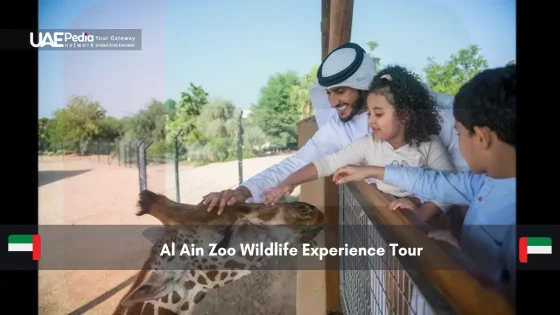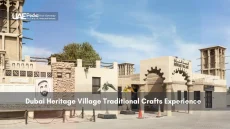Did you know one of Arabia’s largest wildlife reserves sits at the foot of a mountain older than the Himalayas? Nestled against Jebel Hafeet’s ancient slopes, this 217-hectare sanctuary blends adrenaline-pumping safaris with quiet moments of cultural connection—a place where desert foxes dart past acacia trees while storytellers share Bedouin traditions.
Here, meticulously crafted habitats let you observe Arabian oryx herds and playful lemurs up close. Knowledgeable guides—think friendly experts, not textbook reciters—explain how local conservation efforts protect endangered species. You’ll leave understanding why this isn’t just a zoo, but a living bridge between the Emirates’ past and its eco-conscious future.
Families rave about the hands-on encounters: feeding giraffes, spotting cheetahs during golden-hour drives, and watching children’s eyes widen at falconry displays. Every corner sparks discovery, whether you’re learning about date palm cultivation or hearing how ancient trade routes shaped the region’s biodiversity.
Key takeaways:
- Explore a sprawling conservation hub where wildlife roams freely across mountain-backed terrain
- Engage with rare species through interactive activities designed for all ages
- Discover how Emirati heritage and modern eco-innovation coexist seamlessly
Overview of the Al Ain Zoo Wildlife Experience Tour
Picture this: rugged peaks framing endless dunes, where Bedouin traditions whisper through acacia groves. The UAE’s Hajar Mountains cradle a 217-hectare sanctuary—one part living museum, one part species stronghold. Here, ancient trade routes’ legacy meets 21st-century eco-innovation.
Setting the Scene in the UAE
This isn’t your typical arid landscape. The reserve’s design mirrors the region’s natural contours—wadis carved by time, ghaf trees shading sandy pathways. Local architects drew inspiration from Sheikh Zayed’s vision, blending low-impact structures with the environment. Think shaded viewing decks camouflaged against Jurassic-era cliffs.
A Rich Blend of Wildlife and Heritage
Over 4,000 creatures thrive here, from nimble sand gazelles to critically endangered Arabian leopards. But what truly sets this place apart? Its dual role as animal haven and cultural classroom. The Desert Learning Centre decodes Bedouin survival strategies—like tracking stars for navigation—while showcasing cutting-edge breeding programs.
Families bond during sunrise safaris, spotting herds grazing as guides share folktales. Meanwhile, the Sheikh Zayed Desert Initiative’s solar-powered water systems reveal how tradition fuels modern conservation. It’s a living lesson where every dune tells a story.
Experiential Adventures: Safaris, Animal Encounters, and More
There’s a moment when the desert silence breaks—acacia branches rustle as your open-top vehicle crests a dune. Expert guides fluent in both animal behavior and Bedouin lore steer these journeys, their stories making the sands whisper with forgotten caravan tales.
Authentic Safari Journeys and Local Guides
Emirati rangers don’t just point out white rhinos—they decode their social structures. “Watch how the matriarch positions herself,” they’ll say, revealing survival strategies shaped over millennia. These narrators weave ecological insights with regional history, like how ancient trade routes influenced today’s conservation efforts.
Unique Animal Interactions
Feel a giraffe’s sandpaper tongue graze your palm during feeding sessions, or track cheetahs at golden hour. Designed for all ages, encounters spark curiosity: kids giggle as lemurs leap overhead, while adults marvel at the Sheikh Zayed Desert Learning Centre’s breeding programs.
Every activity balances thrill with purpose. Guides explain how solar-powered water systems sustain habitats, turning each safari into a masterclass on coexistence. You leave not just with photos, but with a reshaped view of our planet’s delicate balance.
Embrace the al ain zoo wildlife experience
Where else can you witness the rhythm of Africa blend seamlessly with Emirati innovation? This sanctuary reimagines safari traditions through an Arabian lens—wide-open spaces mimicking savannahs, shaded observation decks perched above watering holes, and rangers who’ll tell you “Every animal here has a story that spans continents.”
Exploring African Safari Inspirations
Morning drives reveal herds grazing beneath rust-colored cliffs, their silhouettes mirroring scenes from the Serengeti. Open-air vehicles navigate terrain shaped to challenge and delight—think sudden dips into dry riverbeds followed by panoramic desert vistas. Guides pause to share how ancient trade routes influenced habitat designs, creating corridors where gazelles roam as freely as their ancestors did.
Passionate Conservation Efforts
Behind the scenes, Emirati teams work tirelessly. “We’re not just protecting species—we’re safeguarding our heritage,” explains a ranger from the Sheikh Zayed Desert Initiative. Their solar-powered hydration stations and breeding programs for rare Arabian leopards show how tradition fuels progress.
Visitors marvel at up-close encounters—feeding giraffes whose eyelashes brush your palm, or spotting sand cats at dusk. These moments aren’t just thrilling—they’re masterclasses in coexistence. Carefully crafted pathways lead you through ecosystems where every shrub placement tells a story of balance.
By day’s end, you’ll understand why this isn’t merely a tour. It’s a living blueprint for preserving Earth’s delicate web—one that honors the past while charting a hopeful future.
Engaging Educational and Conservation Programs
Imagine a classroom where sand cats teach sustainability and ancient irrigation systems reveal climate solutions. The conservation hub here turns curious visitors into informed advocates through immersive learning—no textbooks required.
Interactive Exhibits at the Desert Learning Centre
The Sheikh Zayed Desert Learning Centre redefines eco-innovation. Its LEED Platinum-certified structure uses 40% less water than conventional buildings, with walls that mimic termite mounds for natural cooling. Inside, touchscreens let kids “design” their own drought-resistant ecosystems while augmented reality shows how Bedouin falconry techniques inspired modern drone tech.
“Our job isn’t just feeding animals—it’s sparking curiosity,”
Learning Through Keeper Talks and Safari Tours
Morning chats with caretakers reveal surprising details: why flamingos’ knees bend backward, how GPS collars protect Arabian wolves. Specialized safari tours for families include:
| Tour Type | Duration | Key Features |
|---|---|---|
| Junior Rangers | 90 mins | Track animal footprints, prepare diets |
| Conservation Deep Dive | 3 hours | Habitat restoration workshops |
| Twilight Safari | 2 hours | Nocturnal species observation |
These programs don’t just entertain—they reshape how we see our role in nature’s web. You’ll leave planning backyard pollinator gardens or questioning single-use plastics, proof that education can be as wild as the desert itself.
Practical Guidance for Your Visit
Ever watched a sunrise paint gold across desert sands while planning your day’s adventure? Let’s map your journey through this 217-hectare conservation hub. First rule: mornings are magic. Arrive by 8:30 am to beat both heat and crowds—prime time for spotting giraffes stretching toward dew-kissed acacia leaves.
Optimal Times to Visit and Ticket Information
Gates swing open daily from 9:00 am to 6:00 pm. Adult tickets start at AED 28.35 (about $7.72), while kids under 12 enter for AED 9.45. Pro tip: Book online for express entry. Weekend afternoons buzz with energy, but Tuesday mornings? That’s when patient visitors might catch lions playfully interacting with enrichment toys.
Travel Tips and Nearby Attractions
From Dubai, take E66 southeast—it’s a 90-minute drive with mountain vistas. Parking’s free, but shuttle buses loop the grounds every 15 minutes. Pack light layers: mornings chill at 68°F (20°C), while afternoons soar to 95°F (35°C).
Extend your day with these nearby gems:
- Al Ain Oasis: UNESCO-listed palm groves with 3,000 years of irrigation history
- Qasr Al Muwaiji: Birthplace of Sheikh Khalifa, offering immersive heritage exhibits
- Jebel Hafeet Park: Summit drives with panoramic desert views
Guides recommend keeping 3 feet from animal enclosures—especially during feeding sessions. “Our giraffes adore carrots, but they’ve got Olympic-level reach!” laughs ranger Fatima during safety briefings. With these tips, you’re set to explore nature’s wonders while supporting vital conservation work.
Wrap-Up: Your Wildlife Adventure Awaits
Ever felt the thrill of a lion’s gaze while deciphering Bedouin star navigation? This 217-hectare sanctuary blends heart-pounding adventure with quiet cultural wisdom. From sunrise safaris to twilight keeper chats, every path reveals why this region captivates explorers.
Families bond over giraffe feedings. History buffs marvel at ancient trade route influences on modern habitats. Whether you’re snapping photos of prowling lions or learning about solar-powered food systems, the tours here transform sightseeing into meaningful connections.
Affordable ticket options and shaded pathways make planning stress-free. Morning arrivals unlock cooler temps for exploring the range of exhibits. Pair your visit with nearby palm groves or mountain lookouts for a full-day nature immersion.
This isn’t just another attraction—it’s where Emirati vision meets global conservation. Those golden-hour encounters with majestic creatures? They’re your invitation to join a story larger than yourself. Grab your sunhat. The desert’s living classroom awaits.
Think of it as a mashup of safari thrills and cultural storytelling. You’ll explore habitats inspired by Africa’s savannas, chat with keepers about Arabian species conservation, and even hand-feed giraffes—all while learning how Emirati traditions shape modern wildlife protection.
Absolutely! The Sheikh Zayed Desert Learning Centre’s guides share behind-the-scenes stories about rescued animals and regional ecosystems. Plus, sunset safaris let you spot lions or rhinos when they’re most active—far beyond what standard exhibits offer.
Yes! Junior ranger programs, keeper talks, and the “Adventure Trail” with interactive exhibits keep young explorers engaged. Don’t miss the nocturnal house—it’s a hit for families wanting to see desert creatures like Arabian wolves up close.
Beyond breeding programs for Arabian oryx and sand cats, they partner with global initiatives like the IUCN. Your ticket helps fund habitat restoration and anti-poaching projects—ask staff about their recent success rewilding houbara bustards!
Aim for October to March. Mornings are ideal for walking trails, while afternoons work for shaded exhibits. Summer visits? Opt for early access tickets to beat the heat before 11 AM.
Check their website for bundled passes with Jebel Hafeet or Al Ain Oasis. Pro tip: Pair your zoo day with a sunset drive up Jebel Hafeet—it’s only 30 minutes away and offers epic views of the conservation area.



















